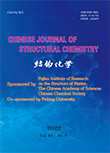Structural and Electronic Properties of Lutetium Doped Germanium Clusters LuGen(+/0/-) (n = 6~19): A Density Functional Theory Investigation
YANG Zhao-Feng, CAO Zhen-Zhu, Aziz U Rehman and YANG Ju-Cai*
Chin. J. Struct. Chem. 2022, 41, 2203155-2203165 DOI: 10.14102/j.cnki.0254-5861.2011-3305
March 15, 2022
lutetium doped germanium clusters, the ground state structure, density functional theory, electronic property
ABSTRACT
Structural
growth mechanism, energetics, and electronic properties of cationic, neutral,
and anionic lutetium doped germanium cluster LuGen(+/0/-) (n = 6~19)
were comprehensively studied by the ABCluster unbiased global search technique
with a hybrid density functional theory approach. Compared to the experimental
PES, the anion evolution of structure can be clearly defined as four-phase:
from the adsorbed to the link structure, then to the half cage motif, and
finally to the endohedral structure. The results revealed that the LuGe16- as Frank-Kasper structure with high symmetry of Td can greatly enhance the stabilities. Doped structures
have shown thermodynamic stability and appropriate energy gap. These materials
are suitable semiconductors. Various approaches, including quasi-spherical
geometry with closed-shell model, aromaticity, UV-Vis spectra, density of
states (DOS) and partial density of states (PDOS) were applied to further
support the results.








